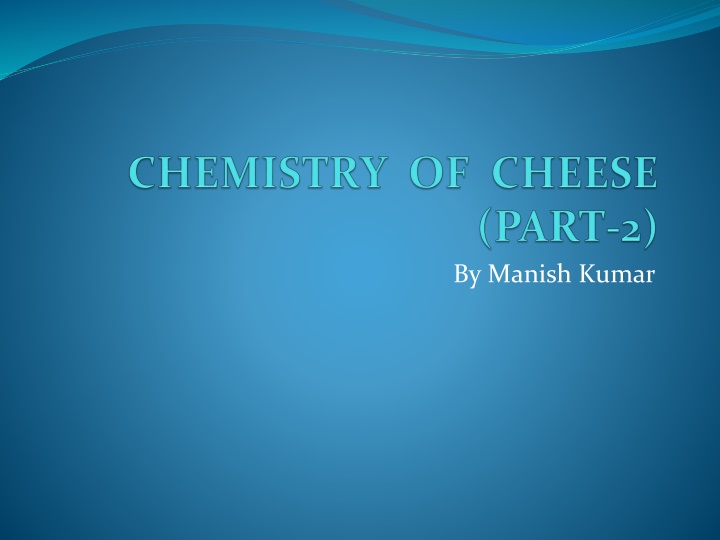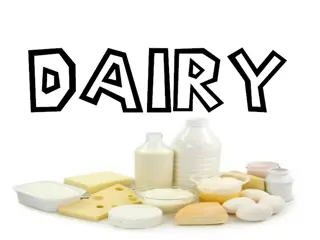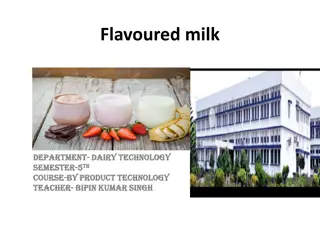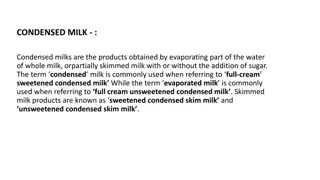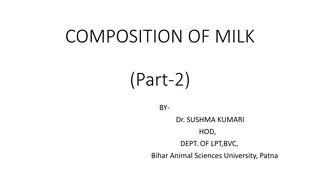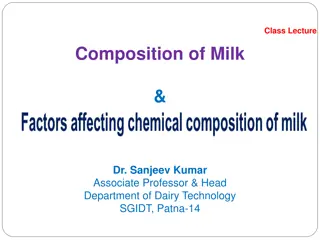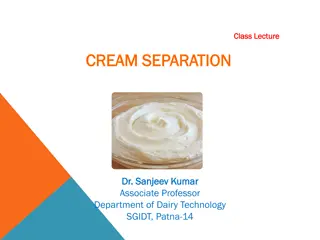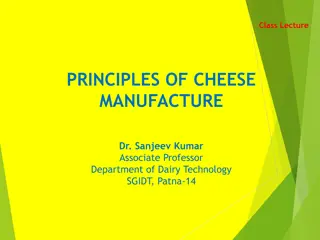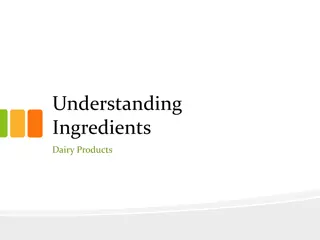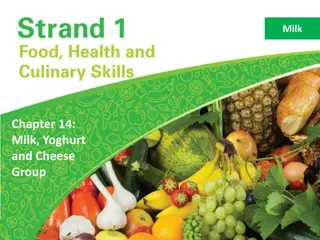Milk Clotting Enzymes - Rennet and Cheese Making Process
Milk clotting enzymes, such as rennet, play a crucial role in cheese making through enzymatic coagulation of milk. Rennet is a complex mixture of enzymes found in mammalian stomachs, particularly in the fourth stomach chamber of young calves. The main enzyme in rennet, chymosin or rennin, coagulates milk by separating it into curds and whey. This process involves specific pH conditions where rennin functions powerfully as a clotting agent. The enzymatic coagulation of milk involves two stages: the production of para casein and peptides, followed by the precipitation of para casein with calcium. This unique reaction alters the structure of casein micelles, leading to the formation of cheese. Understanding the mechanisms behind rennet and enzymatic coagulation of milk is essential for producing high-quality cheeses.
Download Presentation

Please find below an Image/Link to download the presentation.
The content on the website is provided AS IS for your information and personal use only. It may not be sold, licensed, or shared on other websites without obtaining consent from the author.If you encounter any issues during the download, it is possible that the publisher has removed the file from their server.
You are allowed to download the files provided on this website for personal or commercial use, subject to the condition that they are used lawfully. All files are the property of their respective owners.
The content on the website is provided AS IS for your information and personal use only. It may not be sold, licensed, or shared on other websites without obtaining consent from the author.
E N D
Presentation Transcript
Milk Clotting Enzymes Rennet: Rennet is a complex of enzymes produced in any mammalian stomach to digest the mother s milk. Rennet contains many enzymes, including a proteolytic enzyme (protease) that coagulates the milk, causing it to separate into curd and whey. The active enzyme in rennet is called chymosin or rennin but there are also other important enzymes in it, e.g. pepsin and lipase. There are non- animal sources for rennet that are suitable for vegetarian consumption. Natural calf rennet is extracted from the inner mucosa of the fourth stomach chamber (the abomasum) of young, unweand calves. If rennet is extracted from older calves, the rennet contains less or no chymosin but a high level of pepsin.
. Rennin is an enzyme which can function very powerfully as a clotting agent at pH 6.2 to 6.4. The ratio of clotting to proteolytic power of chymosin/ rennin is very high. Conversally, the other enzyme pepsin, functions best at high acidities (pH 1.7 to 2.3) and the ration of clotting to proteolytic power is lower. All proteolytic enzymes can clot milk but the specific value of rennet in Cheese making is that it gives rapid clotting without much proteolysis. Proteolysis by enzymes like pepsin, papain etc. can lead to bitterness in Cheese. The rennet extract from the young milk fed calf contains 88 to 94% rennin and 6 to 12% pepsin.
Enzymatic Coagulation of Milk Rennet coagulation of milk is a two - stage process, the first involving the enzymatic production of para casein and peptides, the second involving the precipitation of para casein by calcium at temperatures above 20 C. The unique reaction in the rennet coagulation of milk is the specific rapid hydrolysis of -casein by acid proteinages causing it to lose its ability to stabalize the calcium- sensitive caseins . The protein chain of -casein (1-169 residues) consists of two quite different segments. One ( the C- terminal ) third of the protein ( 106- 169 residues) is highly negatively charged and is very hydrophilic. The remaining two -third of the molecule ( 1-105 residues) carries a net positive charge and is hydrophobic in nature. The cleavage of a peptide bond (i.e. Phe 105- Met 106) between these two regions in the - casein splits off the hydrophilic portion of the protein (i.e. caseino- peptide) and thereby markedly alters the character of casein micelles. Susuptibility of this bond to cleavage by chymosin /acid
. proteinaseo is very high compared to any other peptide bond in the milk protein system. It is mainly due to the type and sequence of those amino acids immediately surrounding sectile bond (i.e. Phe 105- Met 106). As a consequence of spliting of the sectile bond, the heat charge on the micelles is reduced (from -10/-20 mv to -5/-7 mv) and positively charged sites and exposed which can react with negatively charged groups on their micelles. Removed of protuity peptides from the surfaces also contribute to decrease in inter-miceller repulsive forces. As a result, the altered casein micelle in pressure of Ca interact to form a three dimensional network which become the coagulum. Enzymatic hydrolysis of casein Rennet Casein Para- -casein + Glycomacropeptides (Hydrophobic) (Hydrophilic) Ca , 30 C Gel occuled with fat globules
Cheese Ripening Ripening involves microbial and chemical changes which are responsible for development of typical characteristics of varieties of Cheese. Microbial changes involve death and lysis of the starter cells, development of non- starter microflora and growth of secondary microflora. Ripening usually causes softening of the Cheese texture due to hydrolysis of the casein matrix, change in pH and change in water binding ability of the curd. Flavour production is largely described by a series of biochemical events taking place during ripening. The primary events occuring during Cheese ripening are metabolism of residual lactose, lactate metabolism, proteolysis and lipolysis. These reactions are mainly responsible for textural changes and development of flavour of Cheese. However, many secondary changes occur simultaneously and modify Cheese texture and flavour. Thank You
